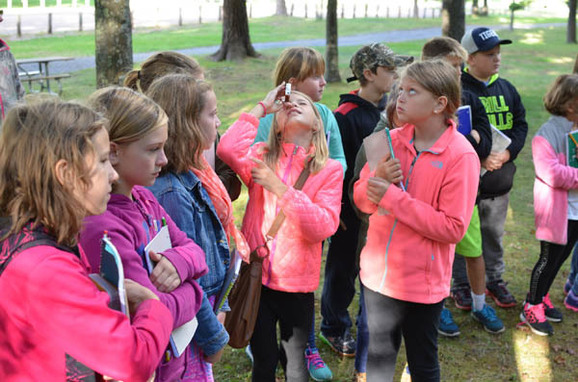 Showcasing the DNR: Getting wild in the
classroom
By HANNAH SCHAUER
Michigan Department of Natural Resources
 Connecting
children to wildlife and other natural resources can be one of the most
exciting, rewarding and fulfilling endeavors for educators and students.
With
another school year beginning, some people may not know the Michigan Department
of Natural Resources provides numerous opportunities to help teachers make
those valuable connections between the state’s natural and cultural resources and
students of all ages.
Elementary students get wild
Through
the Go
Wild for Michigan’s Wildlife curriculum, elementary school educators
can introduce young learners to Michigan’s wildlife species and their habitats.
“Go Wild
for Michigan's Wildlife brought an excitement into my class that I wasn't
anticipating,” said Charlotte Simpson of Shettler Elementary, part of Fruitport
Community Schools in Muskegon. “My youngest of learners – kindergartners – were
engaged in the lessons and materials and were making connections to their
beautiful home state.”
Included
with the lesson plans and activities, are “critter cards,” featuring 19
different Michigan wildlife species.
While
each educator receives a PDF version of the cards, the DNR also prints a
limited supply of the cards, so students can have a set to keep. The available
card sets are distributed to Michigan teachers on a first-come, first-served
basis.
|
 “Throughout
many lessons, I would hear, ‘I've seen that animal before’ or ‘I'm going to
look for that animal tonight when I get home,’" Simpson said.
During
the 2017-2018 school year, over 800 kindergarten through fifth-grade educators
registered to receive this free curriculum.
Middle school is for the bears (and ducks)
Using
actual location data from radio-collared Michigan black bears, middle school
students can find out what bears are up to throughout the year.
A
Year in the Life of a Michigan Black Bear provides lessons,
videos, activities and bear location data to help students learn more about
bear behaviors and habits at various times of the year. Like other DNR wildlife
classroom curricula, this program is offered free of charge.
Sixth-
through eighth-graders will learn all about bear biology, as well as the DNR’s
role in managing bear populations in Michigan. This year, additional bear
location data have been added to the curriculum and educators can choose which
bear, or bears, they want their class to “follow.”
Educator Brandy Dixon, from Holy Ghost Lutheran School in Monroe, said
she uses the curriculum in her classroom and she loves the program.
|
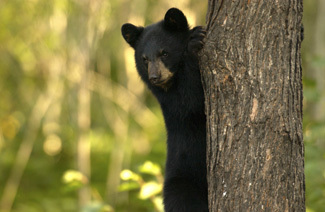 “It was a great way to show my students how there are people in the
state of Michigan whose job it is to protect our natural resources. It
encouraged them to think about how to maintain our environment, and it taught
them about bears,” Dixon said. “They gained in-depth knowledge about these
creatures, and I think that knowledge – because it was spread through an entire
school year – will stick with them for the rest of their lives.”
With knowledge and experience comes greater understanding.
“I had some students who started in my class dead set against hunting,”
Dixon said. “I think they now have more of an understanding as to why hunting, in
particular, is an effective management practice for our Michigan wildlife.”
Classes
that participate in the curriculum also have the option to enter a Year in the
Life of a Michigan Black Bear contest.
After
learning all about black bears in Michigan, students can create a way to share
the story of a black bear’s journey throughout the year. Educators representing
the top three projects are awarded gift certificates to purchase science
supplies for their classroom.
Prizes
for the contest are provided by the Michigan Bear Hunters Association and the
DNR. Learn
about last school year's winners.
The DNR
also offers middle-schoolers curriculum centering on wetlands and some of the
birds that live there.
|
Michigan’s
Wondrous Wetlands and Waterfowl offers an opportunity to learn about the
ducks, geese, and swans found in Michigan, as well as the critical importance
of wetland habitats.
Lessons
include several activities. Students can become a bird in a migration
simulation that illustrates the perils that waterfowl encounter during their
bi-annual flights. Students also will engage in land-use planning, and analyze
Michigan waterfowl population data.
High-schoolers become elk managers
Michigan once had elk across the state, but by the late 1800s,
all the native elk had disappeared due to unregulated hunting and drastic
landscape changes that led to a lack of habitat.
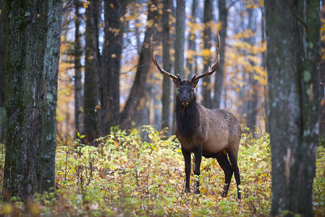 In 1918, seven elk were brought from the western United States
to Wolverine, Michigan to re-establish our state’s elk population.
Now, 100 years later, Michigan has a healthy and abundant elk
population resulting from intentional land management and increased law
enforcement.
Students
can learn more about this conservation success story and celebrate elk in the
classroom with Elk
University.
“This
educational program gives high school students to chance to step into the role
of a wildlife manager,” said Katie Keen, DNR wildlife communications coordinator.
Students
will learn about elk, their habitat needs, Michigan history, wildlife disease
and forest management. They also will explore social considerations for
wildlife management.
“I was
really impressed with the way Elk University uses real data, video and photos
to teach biology concepts, but doesn't ‘preach’ or ‘tell’ information to the
kids,” said Chad Miller of Hamilton High School in Hamilton. “Instead, it
was clear that whoever designed the lessons understood inquiry learning and the
art of getting kids to ‘uncover’ concepts. It is so rare to find –
especially in free, pre-written programs – this approach used so well.”
Elk
University is offered free of charge to ninth through 12th-grade educators.
|
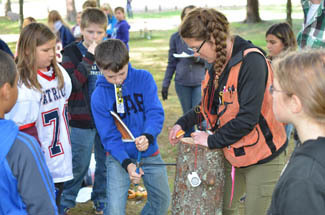 Forests and field trips
“Forests
are critical habitat for many species, such as bear and elk, and a field trip
is a great way to have students experience these resources first-hand after
learning about them in class,” Keen said.
For those
teachers hoping to get their students out for some forest exploration there is
funding available to schools for field trips through a program called “Wheels
to Woods.”
Any pre-kindergarten through 12th-grade school in
Michigan is eligible to apply for funds to go on a field trip to a school
forest, private forest, public forest or forest products company.
“Wheels
to Woods pays for the bus so that students, teachers and parents can go on an
educational field trip to explore a nearby forest,” said Mike Smalligan, DNR
forest stewardship coordinator. “Teachers are free to use any topic about
forests that fits in with their lessons and curriculum.”
For more
information and an application form, visit treefarmsystem.org/wheels-to-woods.
Applications are accepted throughout the year.
If a
field trip is not feasible, educators can incorporate trees, forests and more
into the classroom with Project Learning Tree.
With this
award-winning outdoor curriculum that meets both state and national standards,
educators can find lessons and activities for learners of all ages to
incorporate into classrooms and other educational settings.
Learn
more about Michigan Project Learning Tree at www.michiganplt.org.
|
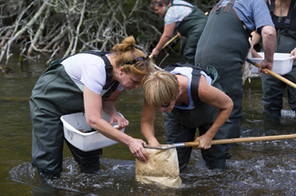 More ways to bring natural resources to the classroom
- Project
WILD workshops offer professional development for bringing hands-on natural
resources-related activities to classrooms. Several Project WILD guide books
for kindergarten through grade 12 are available. Find out more at michigan.gov/michiganprojectwild.
- Get
salmon in the classroom. Caring for young salmon
encourages third- through 12th-grade students to think and care about
conservation and creates a connection between caring for their fish and caring
for their local environment. Learn more about the Salmon in the
Classroom program at michigan.gov/sic.
- The DNR’s
Academy of Natural Resources, a week-long program offered in two locations
during the summer months, gives teachers the opportunity to learn about
Michigan’s diverse natural resources and how to bring that knowledge to the
classroom. Learn more at michigan.gov/anr.
To
register for wildlife classroom curricula and learn about additional
opportunities the DNR has to offer educators, visit michigan.gov/dnreducation.
To get
the latest education updates from the DNR, sign up for DNR emails at michigan.gov/dnr
and choose “Education and Outreach” to subscribe to the Essential Educator newsletter.
The
Michigan DNR offers numerous opportunities for the state’s schoolchildren to
learn about wildlife and natural resources in closer, more involved and more
in-depth ways.
These
opportunities offered for today’s youth may cultivate a bumper crop of wildlife
and natural resources stewards for tomorrow.
That’s what the DNR is aiming for.
Check out
previous Showcasing the DNR stories in our archive at michigan.gov/dnrstories To
subscribe to upcoming Showcasing articles sign-up for free email delivery at michigan.gov/dnr.
|
/Note to editors: Contact: John Pepin, Showcasing
the DNR series editor, at 906-226-1352. Accompanying photos and a text-only
version of this story are available below for download and media use. Suggested
captions follow. Credit: Michigan Department of Natural Resources, unless
otherwise noted.
Bear: A Michigan black bear
is shown.
Cards:
Critter cards, featuring 19 different Michigan wildlife species, are included
with the Go Wild for Michigan’s Wildlife curriculum. The facing card shows a
painted turtle, Michigan’s state reptile.
Core: A student takes a
crack at coring a tree during a Forestry Field Day event at Presque Isle Park
in Marquette County. Wheels to the Woods helped fund transportation for the
event.
Elk: A Michigan elk is
shown.
Group: Aspen Ridge
fifth-grader Kendra Scherer tries to determine the height of a tree by gazing
through a clinometer, while classmate Athena Kinnunen follows the line of
sight. Students Madelyn Reader, Ella Brand and Catherine Bartanen are also
pictured, from left. Wheels to the Woods helped fund transportation for the
Forestry Field Day outing.
Lakeview: Students from Lakeview Community Schools pose for a photo
after visiting their school forest. Wheels
to Woods provides field-trip funding to forests for pre-K through 12th-grade
schools in Michigan.
Release: A student releases
salmon raised in the classroom at the mouth of the Tahquamenon River at Lake
Superior in Chippewa County.
River-1 and River-2:
A fish sampling outing on the AuSable River is shown, part of an Academy of
Natural Resources teacher-training workshop.
Shore: Bob Wild, right, a
park interpreter with Porcupine Mountains Wilderness State Park, and a
teacher-student look at stones collected along the Lake Superior shore as part
of teacher training at the Academy of Natural Resources North.
Students: Whitefish Township
students haul buckets filled with water and salmon raised in their classroom to
the mouth of the Tahquamenon Falls River for release.
Text-only
version story./
|